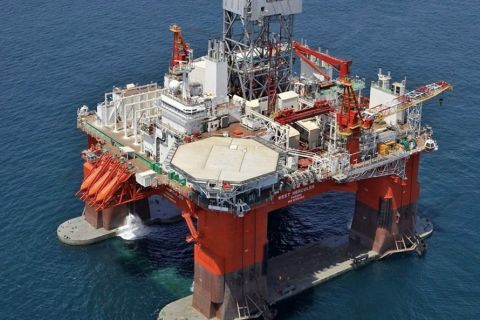Presented by:

Editor's note: This article appears in the new E&P newsletter. Subscribe to the E&P newsletter here.
The default approach of many when it comes to managing such waste, whether from drilling operations, decommissioning activities or production support work scopes, has been to tank it ashore for treatment. It is certainly a straightforward solution but also one that can be resource-intensive and characterized by avoidable safety risks.
Those issues raise questions over cost and efficiency, but a further operational imperative—environmental performance—is influencing decisions on such activities to an ever greater extent. It’s serving to raise the profile of technologies that confine waste management processes to the site itself.
Strategic initiatives such as the North Sea Transition Deal between the U.K. government and industry, published in March, have further incentivized the deployment of solutions that deliver, in a very practical way, on the sustainability agenda.
It means the value-adding principles for waste management now have three key reference points—the three Es: economy, efficiency and, ever more prominently, the environment.
Fluid separation: a growing trend in waste
At-source solutions for separating water, oil and solids take the form of long-established techniques such as mechanical separation. In fact, mechanical separation is already a common feature on many offshore assets as a means of cleaning fuels and oils for operational reuse, delivering efficiency gains for operators. It’s used even more extensively in the shipping industry for the same purpose.
In recent times, however, there is evidence of an increase in the volume of offshore oil and gas projects where onsite fluid separation products and services are being deployed specifically to manage waste, reflecting their ability to deal with everything from oily water and slops to completion or bilge fluids. That sense of growth in this market certainly reflects the industry's experience.
To cite just one example, OSSO was recently contracted to provide mechanical separation services as part of a work scope to clean tanks on an FPSO prior to decommissioning. The operator had initially considered the option of shipping the fluids ashore but opted instead for an at-source solution, involving the supply, installation and management by OSSO of a decanter and disk stack centrifuge system on the asset.
Ultimately, approximately 8,000 cu. m of waste fluids and solids were treated by OSSO products, and about 79% was discharged at the source (the regulatory oil-in-water [OIW] limit for discharge at sea is 30 ppm; in the case of this campaign, which came in ahead of schedule and under budget, the average OIW achieved was 19 ppm).
Economy and efficiency
There are perceptions that onsite waste management does not always represent the optimum solution in terms of cost efficiency and potential maintenance burdens, for example, but correctly deployed it delivers on multiple fronts.
Execution of cleaning the tanks on the FPSO project OSSO worked on exemplified how at-source solutions have the potential to impact the closely interlinked themes of economy and efficiency.
By OSSO's calculations, transporting 8,000 cu. m of materials ashore for disposal would not only have entailed the use of 2,285 skips with a 3.5-cu. m volume capability but also required approximately 16 vessel sailings and 950 truck movements onshore.
Mechanical separation dramatically reduces such logistical commitments, while also easing deck space pressures during operation. It further serves to address any personnel onboard capacity issues and produces a safety risk mitigation outcome. In this particular case, OSSO estimates at least 11,000 crane lifts would have been required for the skip option, which would have necessitated the deployment of a full deck crew.
Environmental dividend
The North Sea Transition Deal has undoubtedly injected fresh impetus into the process of creating a lower carbon future as it committed to early emission reduction targets. Allied to a burgeoning efficiency-focused decommissioning market, it creates a backdrop against which service companies can move beyond the status of product providers and instead become partners in the pursuit of strategic goals.
The deal is the first of its kind by any G7 country and may well shape the strategic approach taken in other energy regions. As the transition philosophy increasingly takes hold internationally, technologies and techniques that support its goals are going to follow the same trail. That presents a new opportunity—an incentive—for supply chain companies. It certainly reflects the mindset at OSSO, where the company is taking a more holistic view of its contribution to decarbonization and thereby looking to grow its activities in markets around the world.
The same project mentioned above illustrates how such an approach can directly help operators pursue their environmental goals.
Cost considerations aside—and such assessments also need to factor in onshore disposal costs of up to £150 per tonne—many of the above statistics serve to illustrate the carbon footprint gain for the operator and showcase how at-source treatment can eliminate the potential environmental risks posed by multiple movements of waste materials.
It is one instance of how economic, efficiency and environmental priorities come into play in this specialist arena. Whereas the first two of those principles might have previously driven the deployment of such solutions—and of course, still do so to a great extent as operators look to optimize commercial performance in tough operating conditions—executives are rightly looking for ways to minimize their environmental impact and reduce their exposure to risks.
Treating fluid waste streams at the source is just one of myriad ways the industry can collectively work to minimize the environmental impact of offshore activity, while still pursuing commercial objectives. The three Es neatly summarize the extent to which it can make a tangible contribution.
Recommended Reading
Orange Basin Serves Up More Light Oil
2024-03-15 - Galp’s Mopane-2X exploration well offshore Namibia found a significant column of hydrocarbons, and the operator is assessing commerciality of the discovery.

